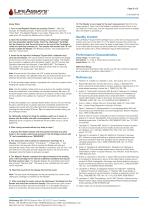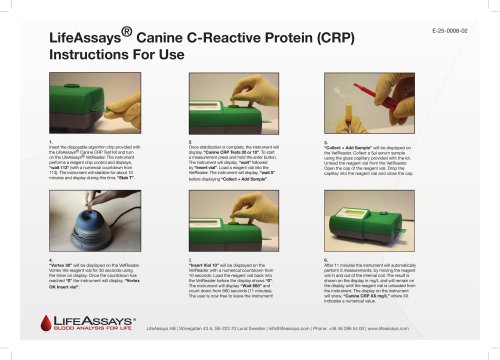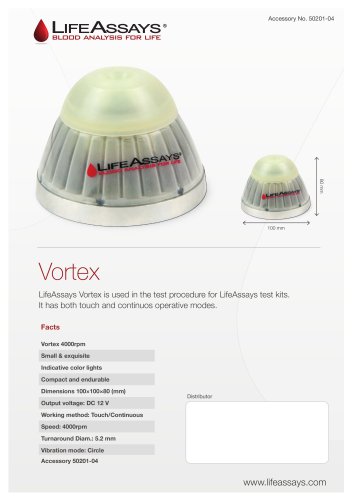
Catalog excerpts

LifeAssays® Equine Serum Amyloid A (eSAA) Test Kit Intended Use The LifeAssays® Equine serum amyloid A (SAA) Test Kit is an in vitro veterinary diagnostic test for the quantitative determination of amyloid A in equine serum. It is intended to be used as an aid in the diagnosis, monitoring and therapy of various inflammatory conditions in horses. An increased concentration of serum amyloid A (SAA), a major equine acute phase protein, is the most sensitive method for detecting systemic inflammation in horses1. Healthy horses have a very low serum SAA concentration, whereas there is a very rapid and large increase in it following an inflammatory stimulus2,3,4. Serum SAA levels increase rapidly after the onset of an inflammatory stimulus (6-12 hours)12 and then, due to SAA’s short serum half-life5, serum concentrations fall rapidly during recovery. SAA is a non-specific inflammatory marker and increased serum concentrations are seen in bacterial infections3,6,7,8, viral infections2,9 and in sterile inflammatory conditions10. Increases in serum SAA concentrations have been shown to correlate with the severity of clinical signs8 and surgical trauma11. Content Information Material Required but Not Supplied with Kit • LifeAssays® Magnia Reader (Art.No. 50101-10) • Capillary holder (Art.No. 40301-04) • A Vortex mixer, e.g. LifeAssays® vortex (Art.No. 50201-04) is not essential, but is recommended Store the test kit and all components at 2–27° C. The test kit is stable until the expiry date printed on the box. Avoid direct sunlight or exposure to temperatures above 27°C. Do not freeze. Test Principle The LifeAssays® eSAA is an immunochromatographic assay utilising superparamagnetic nanoparticles as a label. Testing is performed by adding 3 drops (appr. 75 μL) of diluted sample into the sample well of the LifeAssays® eSAA Cartridge. The sample flows along a nitrocellulose membrane reacting first with anti-SAA labelled with paramagnetic particles and then the SAA-paramagnetic antibody complexes are captured by an anti-SAA antibody in a capture/reading zone. After 5 minutes incubation, the captured paramagnetic particles are read in the Magnia® Reader unit. See assay procedure below for more information. The Magnia® Reader calculates the SAA concentration of the sample and presents the result on the device’s display. The linear range of the LifeAssays® eSAA assay is 10-1000 mg/L. Each LifeAssays® Equine SAA Test Kit is delivered with a lot-specific Calibration Key. The key contains all the reagent data and parameters for a self-executable algorithm, which will calculate and present the eSAA test results in mg/L. The Calibration Key and the LifeAssays® eSAA Cartridge must have same lot number! • For in vitro veterinary diagnostic use only. • Do not mix components from different kit containers. • Do not use test kits past their expiry date. • Do not use damaged or contaminated kits. • Bring all test kit components to room temperature (18-25 °C or 64-77 F) before use. • The Sample Dilution Buffer contains sodium azide in concentrations < 0.1% as a preservative. Sodium azide is a toxic agent. Avoid contact with skin and eyes. Flush abundantly with water upon disposal or if direct contact occurs. • Wear disposable gloves while handling samples, kit reagents, and wash hands thoroughly afterwards. • Disposal of all specimen and test material should be in accordance with state and local law. • If the instructions for use are not carefully followed, erroneous results may be obtained! The LifeAssays® eSAA Assay shall be used only for the in-vitro quantification of SAA in equine serum or plasma samples according to the instructions for use. General laboratory procedures and precautions must be obeyed in handling and disposal of samples and test materials. • Do not re-use LifeAssays® eSAA Cartridges. Do not use expired Cartridges from a lot not showing proper performance when tested with the controls. Do not use a Cartridge from a pouch which has been damaged during storage. Specimen Collection and Preparation The LifeAssays® Equine SAA test can be performed on both serum and EDTA plasma samples. A normal venous blood sample should be taken and the serum or plasma separated appropriately. If not to be tested immediately, serum or plasma can be stored at 2-8 °C for up to ten (10) days or at -20 °C for one month. Note: Repeated freezing and thawing of samples should be avoided. All samples must reach room temperature (18-25 °C or 64-77 F) before testing. Frozen samples must be thawed completely, mixed thoroughly and brought to room temperature before testing is carried out. Free hemoglobin or lipids in the sample do not interfere with test results. Assay Procedure Important Procedural Notes! • All kit components must be allowed to reach room temperature (18-25 °C) before use. • Always use a new and unbroken capillary. Avoid handling the capillary directly with your hands and without gloves (use of capillary holder is recommended). • Sample dilution buffer may stick to the caps of the vials during transport. Shake or tap vials to remove the buffer from the cap prior to use. To avoid loss of buffer, never open a vial that has buffer caught in the cap. • The procedural steps should be performed successively without any interruptions. • Sample dilution buffer vials should be closed tightly after use. • For more information, see the Magnia® Reader’s operator manual. LifeAssays AB, IDEON Science Park, SE-223 70 Lund, Sweden Phone: +46 46 286 54 00, Email: info@lifeassays.com, Web: www
Open the catalog to page 1
Assay Steps 1. Turn on the Magnia® Reader by pressing “Power”. After few seconds, the Reader prompts: “Follow test kit instructions” and then: “Insert Test”. The Magnia® Reader is now ready. Please note, that if it is not used within 20 minutes the Reader will turn itself off. 2. Open the aluminium test pouch having one LifeAssays® Cartridge and one disposable pipette inside. Insert the LifeAssays® Cartridge into the Reader so that the small arrow on the end of the Cartridge is visible and pointing towards you. The sample well marked with “S” will remain outside the Reader. The Reader...
Open the catalog to page 2All Lifeassays catalogs and technical brochures
-
FeLV Ag/FIV Ab Duo
2 Pages
-
Operating manual
2 Pages
-
Vortex flyer
1 Pages




